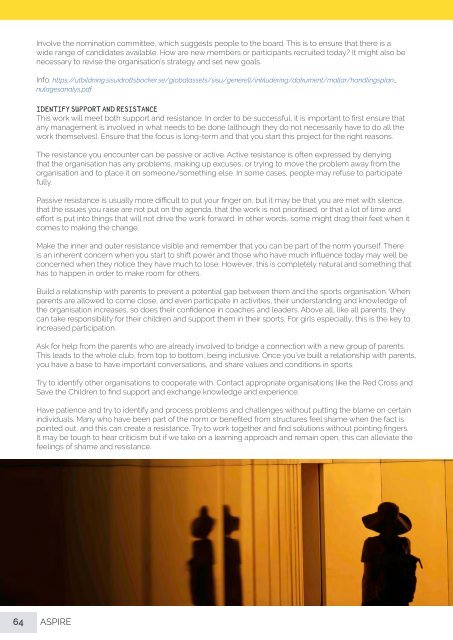181208_Training-Module_interactive
You also want an ePaper? Increase the reach of your titles
YUMPU automatically turns print PDFs into web optimized ePapers that Google loves.
Involve the nomination committee, which suggests people to the board. This is to ensure that there is a<br />
wide range of candidates available. How are new members or participants recruited today? It might also be<br />
necessary to revise the organisation’s strategy and set new goals.<br />
Info: https://utbildning.sisuidrottsbocker.se/globalassets/sisu/generell/inkludering/dokument/mallar/handlingsplan_<br />
nulagesanalys.pdf<br />
IDENTIFY SUPPORT AND RESISTANCE<br />
This work will meet both support and resistance. In order to be successful, it is important to first ensure that<br />
any management is involved in what needs to be done (although they do not necessarily have to do all the<br />
work themselves). Ensure that the focus is long-term and that you start this project for the right reasons.<br />
The resistance you encounter can be passive or active. Active resistance is often expressed by denying<br />
that the organisation has any problems, making up excuses, or trying to move the problem away from the<br />
organisation and to place it on someone/something else. In some cases, people may refuse to participate<br />
fully.<br />
Passive resistance is usually more difficult to put your finger on, but it may be that you are met with silence,<br />
that the issues you raise are not put on the agenda, that the work is not prioritised, or that a lot of time and<br />
effort is put into things that will not drive the work forward. In other words, some might drag their feet when it<br />
comes to making the change.<br />
Make the inner and outer resistance visible and remember that you can be part of the norm yourself. There<br />
is an inherent concern when you start to shift power and those who have much influence today may well be<br />
concerned when they notice they have much to lose. However, this is completely natural and something that<br />
has to happen in order to make room for others.<br />
Build a relationship with parents to prevent a potential gap between them and the sports organisation. When<br />
parents are allowed to come close, and even participate in activities, their understanding and knowledge of<br />
the organisation increases, so does their confidence in coaches and leaders. Above all, like all parents, they<br />
can take responsibility for their children and support them in their sports. For girls especially, this is the key to<br />
increased participation.<br />
Ask for help from the parents who are already involved to bridge a connection with a new group of parents.<br />
This leads to the whole club, from top to bottom, being inclusive. Once you’ve built a relationship with parents,<br />
you have a base to have important conversations, and share values and conditions in sports.<br />
Try to identify other organisations to cooperate with. Contact appropriate organisations like the Red Cross and<br />
Save the Children to find support and exchange knowledge and experience.<br />
Have patience and try to identify and process problems and challenges without putting the blame on certain<br />
individuals. Many who have been part of the norm or benefited from structures feel shame when the fact is<br />
pointed out, and this can create a resistance. Try to work together and find solutions without pointing fingers.<br />
It may be tough to hear criticism but if we take on a learning approach and remain open, this can alleviate the<br />
feelings of shame and resistance.<br />
64 ASPIRE




